Comparison of the Analytic Network Process and the Best–Worst Method in Ranking Urban Resilience and Regeneration Prioritization by Applying Geographic Information Systems
Abstract
1. Introduction
2. Methodology
2.1. Data Sources and Study Area
2.2. Multi-Criteria Decision-Making Models
- Pairwise comparison matrix of ANP methods
- Pairwise comparison matrix of the BWM
- Calculation of criterion weight in the ANP and the BWM
- Validation of questionnaires
- Analysis of the criteria map
- Provision of a resilience map using two methods
- Resilience rating and regeneration prioritization
- Combination of the results of the two methods and their combination.
2.2.1. Analytical Network Process (ANP)
2.2.2. The Best–Worst Method (BWM)
- = 1
- wj ≥ 0, for all j
2.3. Spatial Analysis
2.4. MCDM Implementation
3. Results and Discussion
3.1. Pairwise Comparison and Criteria Weights
3.2. Spatial Distribution of the Criteria
3.3. Spatial Distribution of Neighborhood Resilience
3.4. Discussion
4. Conclusions
Author Contributions
Funding
Data Availability Statement
Acknowledgments
Conflicts of Interest
References
- Wang, X.R.; Hui, E.C.M.; Choguill, C.; Jia, S.H. The New Urbanization Policy in China: Which Way Forward? Habitat Int. 2015, 47, 279–284. [Google Scholar] [CrossRef]
- Guan, X.; Wei, H.; Lu, S.; Dai, Q.; Su, H. Assessment on the Urbanization Strategy in China: Achievements, Challenges and Reflections. Habitat Int. 2018, 71, 97–109. [Google Scholar] [CrossRef]
- United Nations (UN). World Urbanization Prospects: The 2014 Revision; United Nations: New York, NY, USA, 2014. [Google Scholar]
- Elmqvist, T.; Andersson, E.; Frantzeskaki, N.; McPhearson, T.; Olsson, P.; Gaffney, O.; Folke, C. Sustainability and Resilience for Transformation in the Urban Century. Nat. Sustain. 2019, 2, 267–273. [Google Scholar] [CrossRef]
- United Nations (UN). 68% of the World Population Projected to Live in Urban Areas by 2050, Says UN. Available online: https://www.un.org/development/desa/en/news/population/2018-revision-of-world-urbanization-prospects.html (accessed on 18 December 2023).
- Du, J.; Fu, Q.; Fang, S.; Wu, J.; He, P.; Quan, Z. Effects of Rapid Urbanization on Vegetation Cover in the Metropolises of China Over the Last Four Decades. Ecol. Indic. 2019, 107, 105458. [Google Scholar] [CrossRef]
- Manalo, J.A.; Matsumoto, J.; Takahashi, H.G.; Villafuerte, M.Q.; Olaguera, L.M.P.; Ren, G.; Cinco, T.A. The Effect of Urbanization on Temperature Indices in the Philippines. Int. J. Climatol. 2022, 42, 850–867. [Google Scholar] [CrossRef]
- Kaviani, A.; Mansourian, H.; Farhoudi, R. Urban Growth Pattern in Tehran City: Sustainability or Unsustainability. J. Urban Manag. Energy Sustain. 2019, 1, 1–12. [Google Scholar]
- Baharlou-Houreh, N.; Masaeli, N.; Afshari, E.; Mohammadzadeh, K. Performance Analysis of a Proton Exchange Membrane Fuel Cell with the Stair Arrangement of Obstacles in the Cathode Channel. Int. J. Numer. Methods Heat Fluid Flow 2023, 33, 3940–3966. [Google Scholar] [CrossRef]
- Hurlimann, A.; Barnett, J.; Fincher, R.; Osbaldiston, N.; Mortreux, C.; Graham, S. Urban Planning and Sustainable Adaptation to Sea-Level Rise. Landsc. Urban Plan. 2014, 126, 84–93. [Google Scholar] [CrossRef]
- Masaeli, N.; Afshari, E.; Baniasadi, E.; Baharlou-Houreh, N. Performance Studies of a Membrane-Based Water and Heat Exchanger Using Serpentine Flow Channels for Polymer Electrolyte Membrane Fuel Cell Application. Appl. Therm. Eng. 2023, 222, 119950. [Google Scholar] [CrossRef]
- Robinson, J. Cities in a World of Cities: The Comparative Gesture. Int. J. Urban Reg. Res. 2011, 35, 1–23. [Google Scholar] [CrossRef]
- Sadidi, J.; Maleki, M.; Rahmati, M.; Tavakkoli, S.M. Investigating the Role of Faults in the Establishment and Survival of Settlements Using Remote Sensing and Geographic Information System (GIS). The Case of Sahneh County in Iran. J. Settl. Spat. Plan. 2016, 7, 201–206. [Google Scholar]
- Kiambi, S.; Alarcon, P.; Rushton, J.; Murungi, M.K.; Muinde, P.; Akoko, J.; Fèvre, E.M. Mapping Nairobi’s Dairy Food System: An Essential Analysis for Policy, Industry and Research. Agric. Syst. 2018, 167, 47–60. [Google Scholar] [CrossRef]
- Girard, L.F. Creativity and the Human Sustainable City: Principles and Approaches for Nurturing City Resilience. In Sustainable City and Creativity: Promoting Creative Urban Initiatives. Available online: https://www.taylorfrancis.com/books/e/9781317047957/chapters/10.4324/9781315611464-13 (accessed on 29 October 2018).
- Falco, G.J. City Resilience through Data Analytics: A Human-Centric Approach. Procedia Eng. 2015, 118, 1008–1014. [Google Scholar] [CrossRef]
- Jia, Z.; Li, S.; Wang, L. Assessment of Soil Heavy Metals for Eco-Environment and Human Health in a Rapidly Urbanization Area of the Upper Yangtze Basin. Sci. Rep. 2018, 8, 3256. [Google Scholar] [CrossRef] [PubMed]
- Zhu, S.; Li, D.; Feng, H. Is Smart City Resilient? Evidence from China. Sustain. Cities Soc. 2019, 50, 101636. [Google Scholar] [CrossRef]
- Zabaniotou, A. A Systemic Approach to Resilience and Ecological Sustainability During the COVID-19 Pandemic: Human, Societal, and Ecological Health as a System-Wide Emergent Property in the Anthropocene. Glob. Transit. 2020, 2, 116–126. [Google Scholar] [CrossRef] [PubMed]
- Abjani, F.; Madhavan, P.; Chong, P.P.; Chinna, K.; Rhodes, C.A.; Lim, Y.A.L. Urbanization and Its Associated Factors Affecting Human Gut Microbiota: Where Are We Heading To? Ann. Hum. Biol. 2023, 50, 137–147. [Google Scholar] [CrossRef]
- Sharifi, A.; Yamagata, Y. Resilience-Oriented Urban Planning. In Resilience-Oriented Urban Planning: Theoretical and Empirical Insights; Springer: Berlin/Heidelberg, Germany, 2018; pp. 3–27. [Google Scholar]
- Herrman, H.; Stewart, D.E.; Diaz-Granados, N.; Berger, E.L.; Jackson, B.; Yuen, T. What Is Resilience? Can. J. Psychiatry 2011, 56, 258–265. [Google Scholar]
- Abdoli, N.; Hosseinzadeh, A. Assessing Spatial Equity of Public Transit Demand Amid COVID-19. In International Conference on Transportation and Development 2021; ASCE: Austin, TX, USA, 2021; pp. 513–520. [Google Scholar]
- Masaeli, N.; Afshari, E.; Baniasadi, E.; Baharlou-Houreh, N.; Ghaedamini, M.J.A.E. Experimental Analysis of Water Transfer and Thermal–Hydraulic Performance of Membrane Humidifiers with Three Flow Field Designs. Appl. Energy 2023, 336, 120823. [Google Scholar] [CrossRef]
- Farzad Behtash, M.R.; Keynejhad, M.A.; Taghi Pirbabaei, M.; Asgary, A. Evaluation and Analysis of Dimensions and Components of Tabriz Metropolis Resiliency. Honar-Ha-Ye-Ziba Memary Va Shahrsazi 2013, 18, 33–42. [Google Scholar]
- Jamil, S. Suffering in Silence: The Resilience of Pakistan’s Female Journalists to Combat Sexual Harassment, Threats and Discrimination. J. Pract. 2020, 14, 150–170. [Google Scholar] [CrossRef]
- Kalniete, S.; Pildegovičs, T. Strengthening the EU’s Resilience to Hybrid Threats. Eur. View 2021, 20, 23–33. [Google Scholar] [CrossRef]
- Ertan, T.; Eğercioğlu, Y. Historic City Center Urban Regeneration: Case of Malaga and Kemeraltı, Izmir. Procedia-Soc. Behav. Sci. 2016, 223, 601–607. [Google Scholar] [CrossRef]
- Durantini, M. Regenerating the Urban Outskirts: A Self-Sufficient Ecovillage in Milan’s Bovisasca Area. Ph.D. Thesis, Politecnico di Torino, Torino, Italy, 2023. [Google Scholar]
- Romero-Lankao, P.; Gnatz, D.M.; Wilhelmi, O.; Hayden, M. Urban Sustainability and Resilience: From Theory to Practice. Sustainability 2016, 8, 1224. [Google Scholar] [CrossRef]
- Korkmaz, C.; Balaban, O. Sustainability of Urban Regeneration in Turkey: Assessing the Performance of the North Ankara Urban Regeneration Project. Habitat Int. 2020, 95, 102081. [Google Scholar] [CrossRef]
- McLafferty, S.L. GIS and Health Care. Annu. Rev. Public Health 2003, 24, 25–42. [Google Scholar] [CrossRef] [PubMed]
- Zhao, L.; Mbachu, J.; Liu, Z. Developing an Integrated BIM+GIS Web-Based Platform for a Mega Construction Project. KSCE J. Civ. Eng. 2022, 26, 1505–1521. [Google Scholar] [CrossRef]
- Yao, S.; Loo, B.P.; Yang, B.Z. Traffic Collisions in Space: Four Decades of Advancement in Applied GIS. Ann. GIS 2016, 22, 1–14. [Google Scholar] [CrossRef]
- Maleki, M.; Asadi, M.; Naghadehi, S.Z.; Khosravi, A.; Wang, J.; Stewart, I.D.; Shakeryari, M. Detecting Local Climate Zone Change and Its Effects on PM10 Distribution Using Fuzzy Machine Learning in Tehran, Iran. Urban Clim. 2023, 49, 101506. [Google Scholar] [CrossRef]
- Kazemi Garajeh, M.; Haji, F.; Tohidfar, M.; Sadeqi, A.; Ahmadi, R.; Kariminejad, N. Spatiotemporal Monitoring of Climate Change Impacts on Water Resources Using an Integrated Approach of Remote Sensing and Google Earth Engine. Sci. Rep. 2024, 14, 5469. [Google Scholar] [CrossRef]
- Maleki, M.; Van Genderen, J.L.; Tavakkoli-Sabour, S.M.; Saleh, S.S.; Babaee, E. Land Use/Cover Change in Dinevar Rural Area of West Iran During 2000–2018 and Its Prediction for 2024 and 2030. Geogr. Tech. 2020, 15, 93–105. [Google Scholar] [CrossRef]
- Wang, J.; Bretz, M.; Dewan, M.A.A.; Delavar, M.A. Machine Learning in Modelling Land-Use and Land Cover-Change (LULCC): Current Status, Challenges and Prospects. Sci. Total Environ. 2022, 822, 153559. [Google Scholar] [CrossRef] [PubMed]
- Jasrotia, A.S.; Majhi, A.; Singh, S. Water Balance Approach for Rainwater Harvesting Using Remote Sensing and GIS Techniques, Jammu Himalaya, India. Water Resour. Manag. 2009, 23, 3035–3055. [Google Scholar] [CrossRef]
- Li, Y.; Abdelkareem, M.; Al-Arifi, N. Mapping Potential Water Resource Areas Using GIS-Based Frequency Ratio and Evidential Belief Function. Water 2023, 15, 480. [Google Scholar] [CrossRef]
- Sun, C.G.; Chun, S.H.; Ha, T.G.; Chung, C.K.; Kim, D.S. Development and Application of a GIS-Based Tool for Earthquake-Induced Hazard Prediction. Comput. Geotech. 2008, 35, 436–449. [Google Scholar] [CrossRef]
- Makinano-Santillan, M.; Serviano, J.; Rubillos, C.K.; Amora, A.; Santillan, J.R.; Morales, E.M.; Gingo, A.L. Near-Real Time Hazard Monitoring and Information Dissemination through Integration of Remote Sensing, GIS, Numerical Modelling, Web Applications and Social Media. ISPRS Ann. Photogramm. Remote Sens. Spatial Inf. Sci. 2019, 4, 25–32. [Google Scholar] [CrossRef]
- Maleki, M.; Salman, M.; Sahebi Vayghan, S.; Szabo, S. GIS-Based Sinkhole Susceptibility Mapping Using the Best Worst Method. Spat. Inf. Res. 2023, 31, 537–545. [Google Scholar] [CrossRef]
- Doan, T.; Guo, X. Understanding Bison Carrying Capacity Estimation in Northern Great Plains Using Remote Sensing and GIS. Can. J. Remote Sens. 2019, 45, 139–162. [Google Scholar] [CrossRef]
- Rikalovic, A.; Cosic, I.; Lazarevic, D. GIS Based Multi-criteria Analysis for Industrial Site Selection. Procedia Eng. 2014, 69, 1054–1063. [Google Scholar] [CrossRef]
- Karimi, H.; Hossini, H.; Amin, A.A. Municipal Landfill Site Selection and Environmental Impacts Assessment Using Spatial Multi-criteria Decision Analysis: A Case Study. In Computers in Earth and Environmental Sciences; Elsevier: Amsterdam, The Netherlands, 2022; pp. 235–244. [Google Scholar]
- Yeh, A.G. Urban Planning and GIS. Geogr. Inf. Syst. 1999, 2, 1. [Google Scholar]
- City Resilience Index. Available online: https://www.arup.com/insights/city-resilience-index/#:~:text=The%20City%20Resilience%20Index%20has,measure%20relative%20performance%20over%20time (accessed on 30 June 2024).
- Ebrahimi Sirizi, M.; Taghavi Zirvani, E.; Esmailzadeh, A.; Khosravian, J.; Ahmadi, R.; Mijani, N.; Jokar Arsanjani, J. A Scenario-Based Multi-Criteria Decision-Making Approach for Allocation of Pistachio Processing Facilities: A Case Study of Zarand, Iran. Sustainability 2023, 15, 15054. [Google Scholar] [CrossRef]
- Khosravian, J.; Qureshi, S.; Rostamzadeh, S.; Moradi, B.; Derakhshesh, P.; Yousefi, S.; Nickravesh, F. Evaluating the Feasibility of Constructing Shopping Centers on Urban Vacant Land through a Spatial Multi-Criteria Decision-Making Model. Front. Sustain. Cities 2024, 6, 1373331. [Google Scholar] [CrossRef]
- Lee, G.; Choi, J.; Jun, K.S. MCDM Approach for Identifying Urban Flood Vulnerability under Social Environment and Climate Change. J. Coastal Res. 2017, 79, 209–213. [Google Scholar] [CrossRef]
- Aghmashhadi, A.H.; Azizi, A.; Hoseinkhani, M.; Zahedi, S.; Cirella, G.T. Aquaculture Site Selection of Oncorhynchus Mykiss (Rainbow Trout) in Markazi Province Using GIS-Based MCDM. ISPRS Int. J. Geo-Inf. 2022, 11, 157. [Google Scholar] [CrossRef]
- Lu, P.; Sun, Y.; Steffen, N. Scenario-Based Performance Assessment of Green-Grey-Blue Infrastructure for Flood-Resilient Spatial Solution: A Case Study of Pazhou, Guangzhou, Greater Bay Area. Landsc. Urban Plan. 2023, 238, 104804. [Google Scholar] [CrossRef]
- Vytautas, B.; Marija, B.; Vytautas, P. Assessment of Neglected Areas in Vilnius City Using MCDM and COPRAS Methods. Procedia Eng. 2015, 122, 29–38. [Google Scholar] [CrossRef]
- Vijith, H.; Dodge-Wan, D. Modelling Terrain Erosion Susceptibility of Logged and Regenerated Forested Region in Northern Borneo through the Analytical Hierarchy Process (AHP) and GIS Techniques. Geoenvironmental Disasters 2019, 6, 1–18. [Google Scholar] [CrossRef]
- Kara, C.; Iranmanesh, A. Modelling and Assessing Sustainable Urban Regeneration for Historic Urban Quarters via Analytical Hierarchy Process. Land 2022, 12, 72. [Google Scholar] [CrossRef]
- Shen, L.Y.; Ochoa, J.J.; Shah, M.N.; Zhang, X. The Application of Urban Sustainability Indicators–A Comparison Between Various Practices. Habitat Int. 2011, 35, 17–29. [Google Scholar] [CrossRef]
- Haghshenas, H.; Vaziri, M. Urban Sustainable Transportation Indicators for Global Comparison. Ecol. Indic. 2012, 15, 115–121. [Google Scholar] [CrossRef]
- Muñoz-Erickson, T.A.; Meerow, S.; Hobbins, R.; Cook, E.; Iwaniec, D.M.; Berbés-Blázquez, M.; Robles-Morua, A. Beyond Bouncing Back? Comparing and Contesting Urban Resilience Frames in US and Latin American Contexts. Landsc. Urban Plan. 2021, 214, 104173. [Google Scholar] [CrossRef]
- Maleki, M.; Tavakkoli Sabour, S.M.; Zeaieanfirouzabadi, P.; Raeisi, M. Comparison of Optic and Radar Data for Terrain Feature Extraction. J. RS GIS Nat. Resour. 2018, 9, 93–107. [Google Scholar]
- Lak, A.; Gheitasi, M.; Timothy, D.J. Urban Regeneration through Heritage Tourism: Cultural Policies and Strategic Management. J. Tour. Cult. Change 2020, 18, 386–403. [Google Scholar] [CrossRef]
- Lak, A.; Hakimian, P.; Sharifi, A. An Evaluative Model for Assessing Pandemic Resilience at the Neighborhood Level: The Case of Tehran. Sustain. Cities Soc. 2021, 75, 103410. [Google Scholar] [CrossRef] [PubMed]
- Khankeh, H.R.; Farrokhi, M.; Khanjani, M.S.; Momtaz, Y.A.; Forouzan, A.S.; Norouzi, M.; Saatchi, M. The barriers, challenges, and strategies of COVID-19 (SARS-CoV-2) vaccine acceptance: A concurrent mixed-method study in Tehran City, Iran. Vaccines 2021, 9, 1248. [Google Scholar] [CrossRef]
- Ahani, M.; Arjmandi, R.; Hoveidi, H.; Ghodousi, J.; Miri Lavasani, M.R. A multi-objective optimization model for municipal waste management system in Tehran city, Iran. Int. J. Environ. Sci. Technol. 2019, 16, 5447–5462. [Google Scholar] [CrossRef]
- Farhadikhah, H.; Ziari, K. Social sustainability between old and new neighborhoods (case study: Tehran neighborhoods). Environ. Dev. Sustain. 2021, 23, 2596–2613. [Google Scholar] [CrossRef]
- Motlagh, S.H.B.; Pons, O.; Hosseini, S.A. Sustainability model to assess the suitability of green roof alternatives for urban air pollution reduction applied in Tehran. Build. Environ. 2021, 194, 107683. [Google Scholar] [CrossRef]
- Rashidi, M.; Seyedhosseini, S.M.; Naderan, A. Defining Psychological Factors of Cycling in Tehran City. Sustainability 2023, 15, 3264. [Google Scholar] [CrossRef]
- Shastri, PC Resilience: Building immunity in psychiatry. Indian J. Psychiatry 2013, 55, 224. [CrossRef]
- Marques, T.A.; Thomas, L.; Martin, S.W.; Mellinger, D.K.; Ward, J.A.; Moretti, D.J.; Tyack, P.L. Estimating animal population density using passive acoustics. Biol. Rev. 2013, 88, 287–309. [Google Scholar] [CrossRef] [PubMed]
- Gonçalves, D.N.S.; de Morais Gonçalves, C.; de Assis, T.F.; da Silva, M.A. Analysis of the difference between the Euclidean distance and the actual road distance in Brazil. Transp. Res. Procedia 2014, 3, 876–885. [Google Scholar] [CrossRef]
- Goldenberg, S.Z.; Douglas-Hamilton, I.; Wittemyer, G. Vertical transmission of social roles drives resilience to poaching in elephant networks. Curr. Biol. 2016, 26, 75–79. [Google Scholar] [CrossRef]
- O’donnell, L.; O’donnell, C.; Wardlaw, D.M.; Stueve, A. Risk and resiliency factors influencing suicidality among urban African American and Latino youth. Am. J. Community Psychol. 2004, 33, 37–49. [Google Scholar] [CrossRef]
- Abshirini, E.; Koch, D. Resilience, space syntax and spatial interfaces: The case of river cities. A|Z ITU J. Fac. Archit. 2017, 14, 25–41. [Google Scholar] [CrossRef]
- Salimi, M.; Al-Ghamdi, S.G. Climate change impacts on critical urban infrastructure and urban resiliency strategies for the Middle East. Sustain. Cities Soc. 2020, 54, 101948. [Google Scholar] [CrossRef]
- Gorji, M.A.; Hadavi, N.; Nahavandi, N. Improving urban resilience against climate change through government tax policies to housing companies: A game-theoretic approach. Urban Clim. 2023, 49, 101565. [Google Scholar] [CrossRef]
- Ahmadi, R.; Ghahremani, S.; Kivi, S.B.; Bayat, F.; Zareh, N.; Rohani, A.; Janianpour, P. Investigating social factors of residential satisfaction and the impact on housing price in spontaneous settlements in Tehran fringe. Open Access Libr. J. 2022, 9, 1–21. [Google Scholar] [CrossRef]
- Honey-Rosés, J. Urban resilience in perspective: Tracing the origins and evolution of urban green spaces in Barcelona. In Urban Resilience to the Climate Emergency: Unravelling the Transformative Potential of Institutional and Grassroots Initiatives; Springer International Publishing: Cham, Switzerland, 2022; pp. 45–63. [Google Scholar]
- Kordi, F.; Yousefi, H. Crop classification based on phenology information by using time series of optical and synthetic-aperture radar images. Remote Sens. Appl. Soc. Environ. 2022, 27, 100812. [Google Scholar] [CrossRef]
- Bertilsson, L.; Wiklund, K.; de Moura Tebaldi, I.; Rezende, O.M.; Veról, A.P.; Miguez, M.G. Urban flood resilience–A multi-criteria index to integrate flood resilience into urban planning. J. Hydrol. 2019, 573, 970–982. [Google Scholar] [CrossRef]
- Apostu, S.A.; Vasile, V.; Vasile, R.; Rosak-Szyrocka, J. Do Smart Cities Represent the Key to Urban Resilience? Rethinking Urban Resilience. Int. J. Environ. Res. Public Health 2022, 19, 15410. [Google Scholar] [CrossRef] [PubMed]
- Colding, J. ‘Ecological land-use complementation’ for building resilience in urban ecosystems. Landsc. Urban Plan. 2007, 81, 46–55. [Google Scholar] [CrossRef]
- Saaty, T.L.; Vargas, L.G. Decision Making with the Analytic Network Process; Springer Science+Business Media, LLC: Berlin, Germany, 2006; Volume 282. [Google Scholar]
- Asadabadi, M.R.; Chang, E.; Saberi, M. Are MCDM methods useful? A critical review of analytic hierarchy process (AHP) and analytic network process (ANP). Cogent Eng. 2019, 6, 1623153. [Google Scholar] [CrossRef]
- Maleki, M.; Jozak, A.; Sadidi, J. Identification of sinkhole prone areas in Biston-Paro karst basin. J. Geogr. Stud. Mountainous Areas 2020, 3, 67–80. [Google Scholar]
- Kasiri, Z.; Habibnejad Roshan, M.; Roshun, S.H. Groundwater Resources Potential Based on Geographic Information System (GIS) and Remote Sensing (RS) Using Analytic Network Process (ANP) (Case Study: Naz Sari Plain). Geogr. Environ. Plan. 2020, 31, 103–120. [Google Scholar]
- Han, Y.; Wang, Z.; Lu, X.; Hu, B. Application of AHP to road selection. ISPRS Int. J. Geo-Inf. 2020, 9, 86. [Google Scholar] [CrossRef]
- Haghighi Fard, S.M.; Doratli, N. Evaluation of resilience in historic urban areas by combining multi-criteria decision-making system and GIS, with sustainability and regeneration approach: The case study of Tehran (IRAN). Sustainability 2022, 14, 2495. [Google Scholar] [CrossRef]
- Rezaei, J. Best-worst multi-criteria decision-making method. Omega 2015, 53, 49–57. [Google Scholar] [CrossRef]
- Rezaei, J. Best-worst multi-criteria decision-making method: Some properties and a linear model. Omega 2016, 64, 126–130. [Google Scholar] [CrossRef]
- Lim, Y.J.; Basri, N.A. Sites Selection for a Potential Radioactive Waste Repository in Peninsular Malaysia: GIS-Based Weight Linear Combination and Multi-criteria Decision-Making Analysis. Prog. Nucl. Energy 2022, 149, 104252. [Google Scholar] [CrossRef]
- Dhurkari, R.K. MCDM methods: Practical difficulties and future directions for improvement. RAIRO-Oper. Res. 2022, 56, 2221–2233. [Google Scholar] [CrossRef]
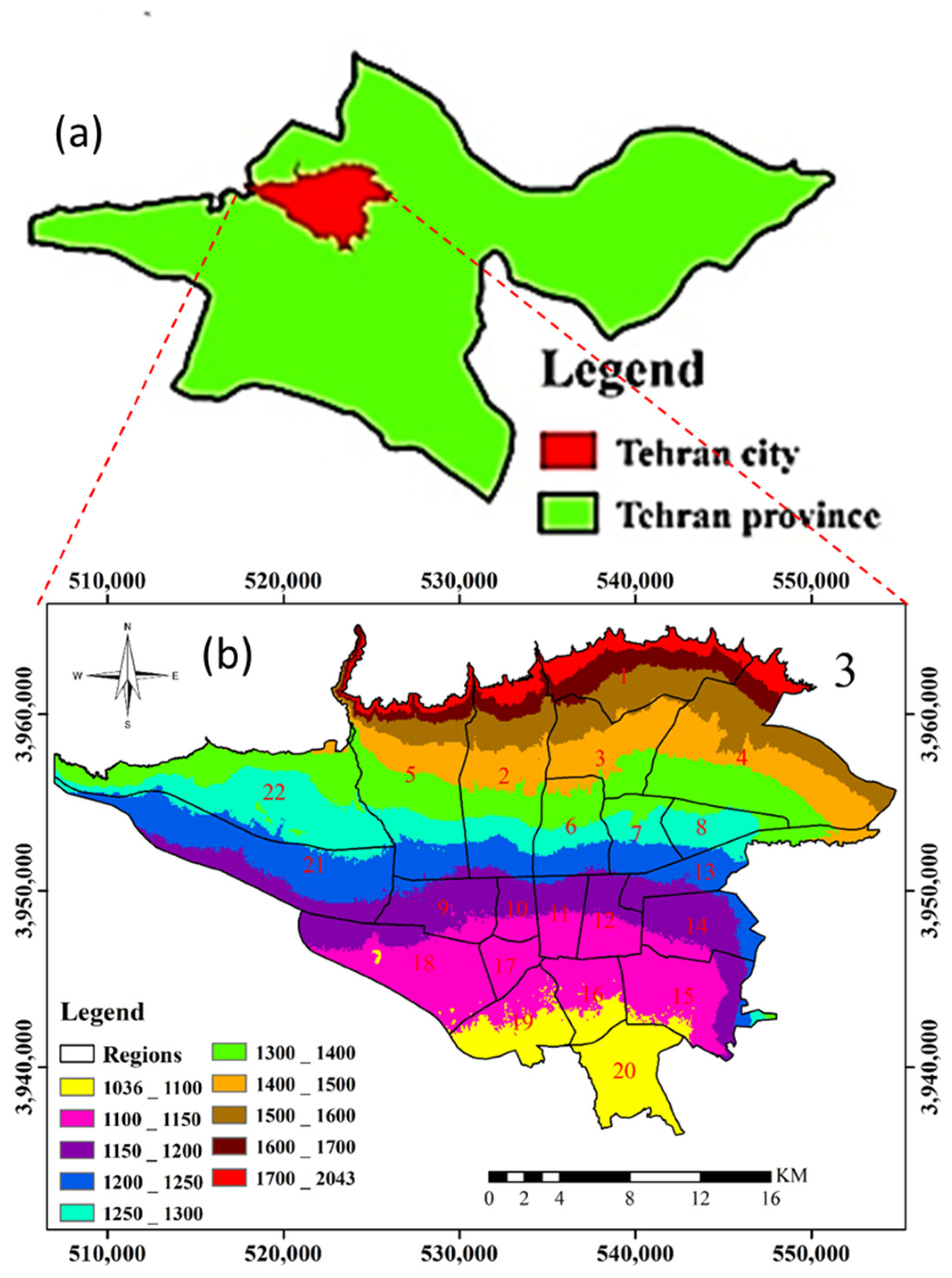
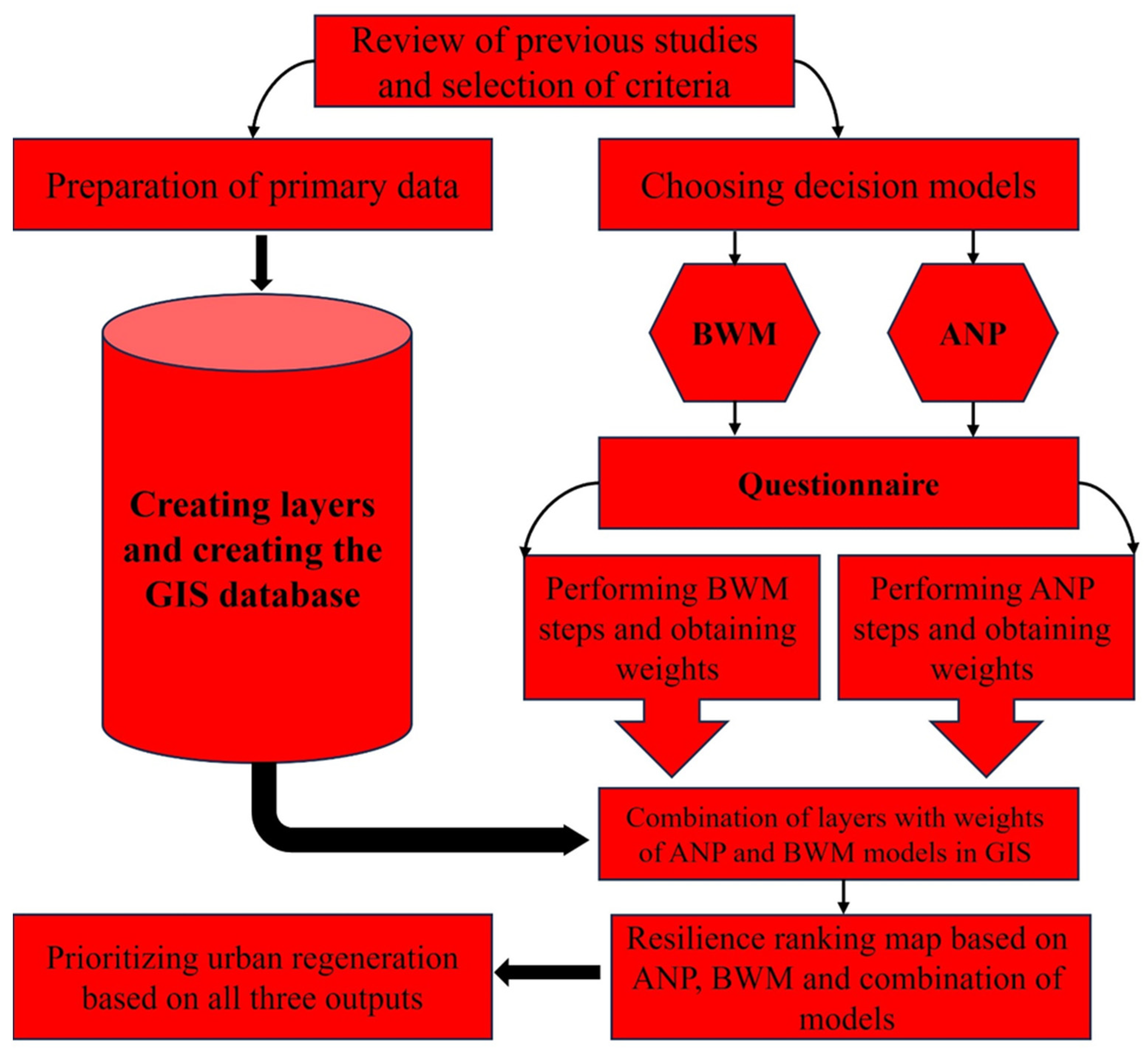
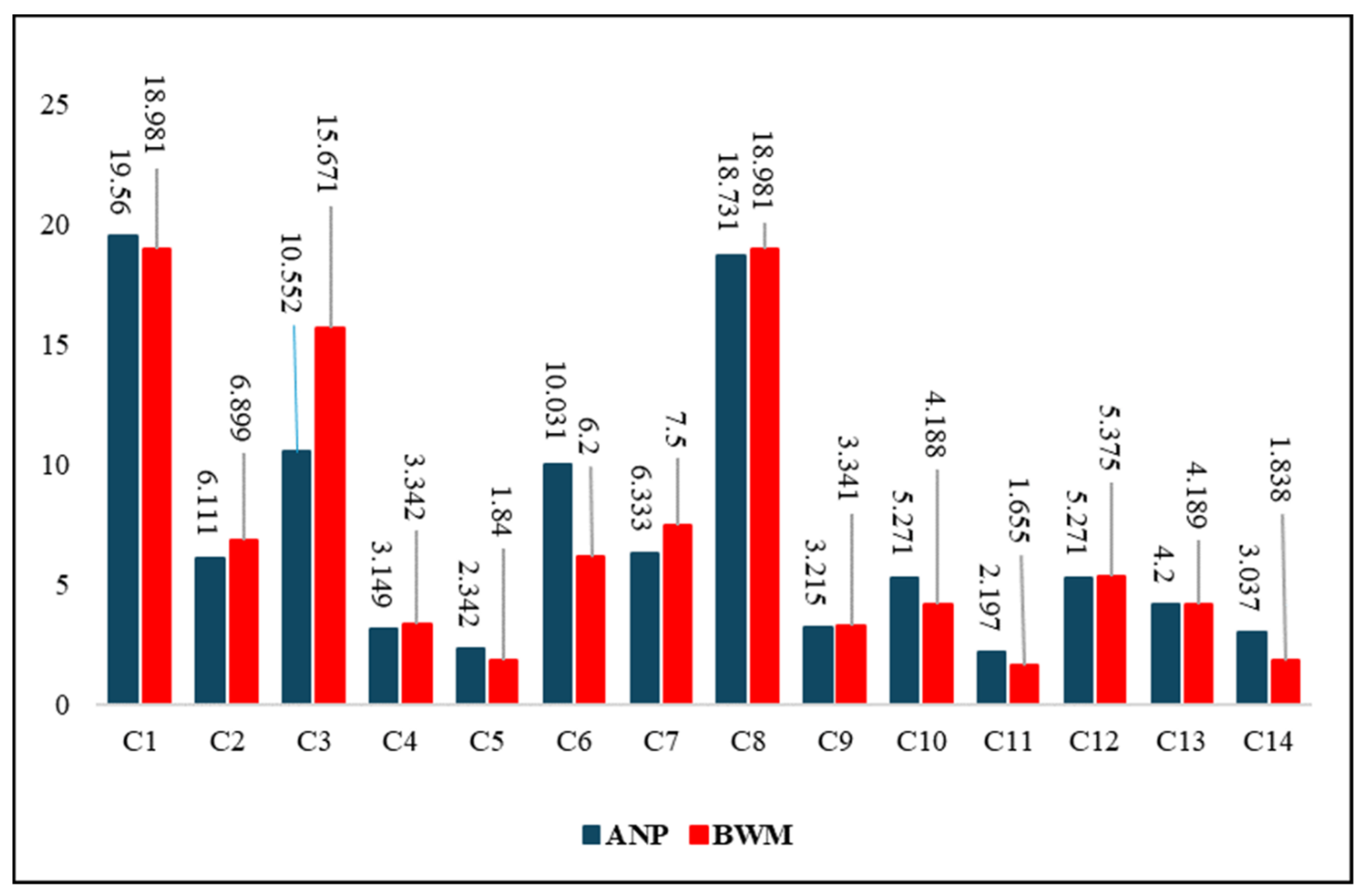
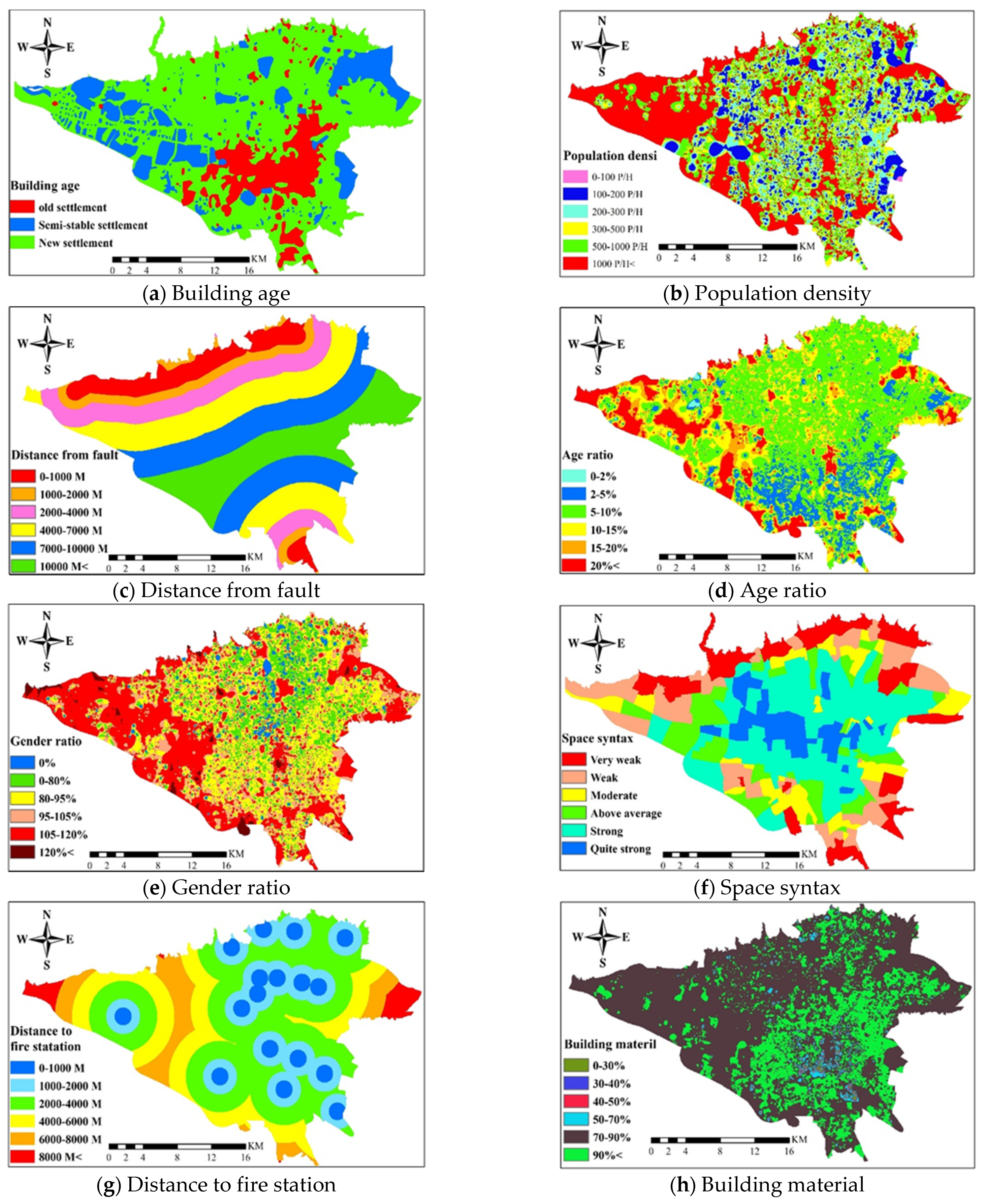
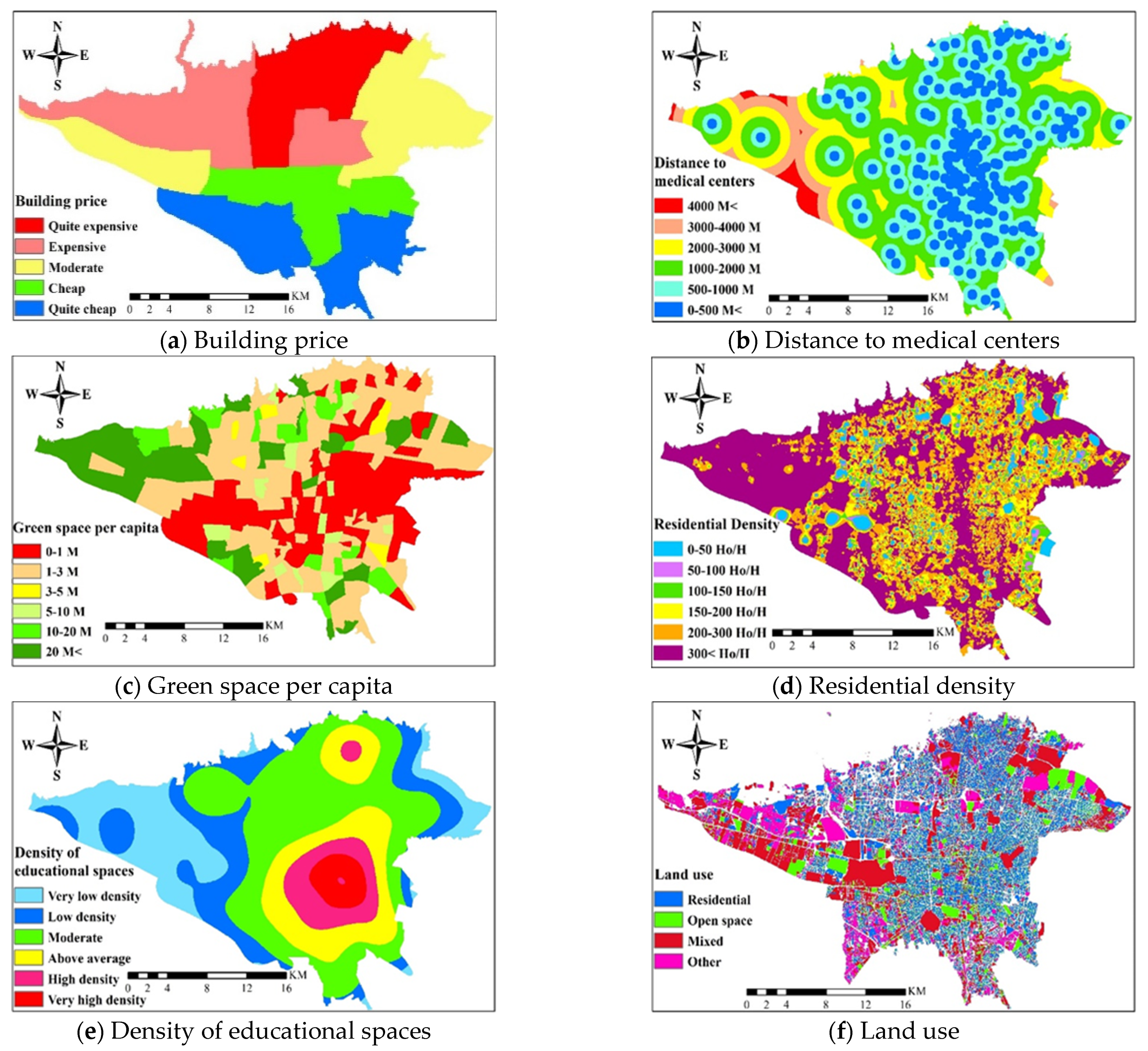

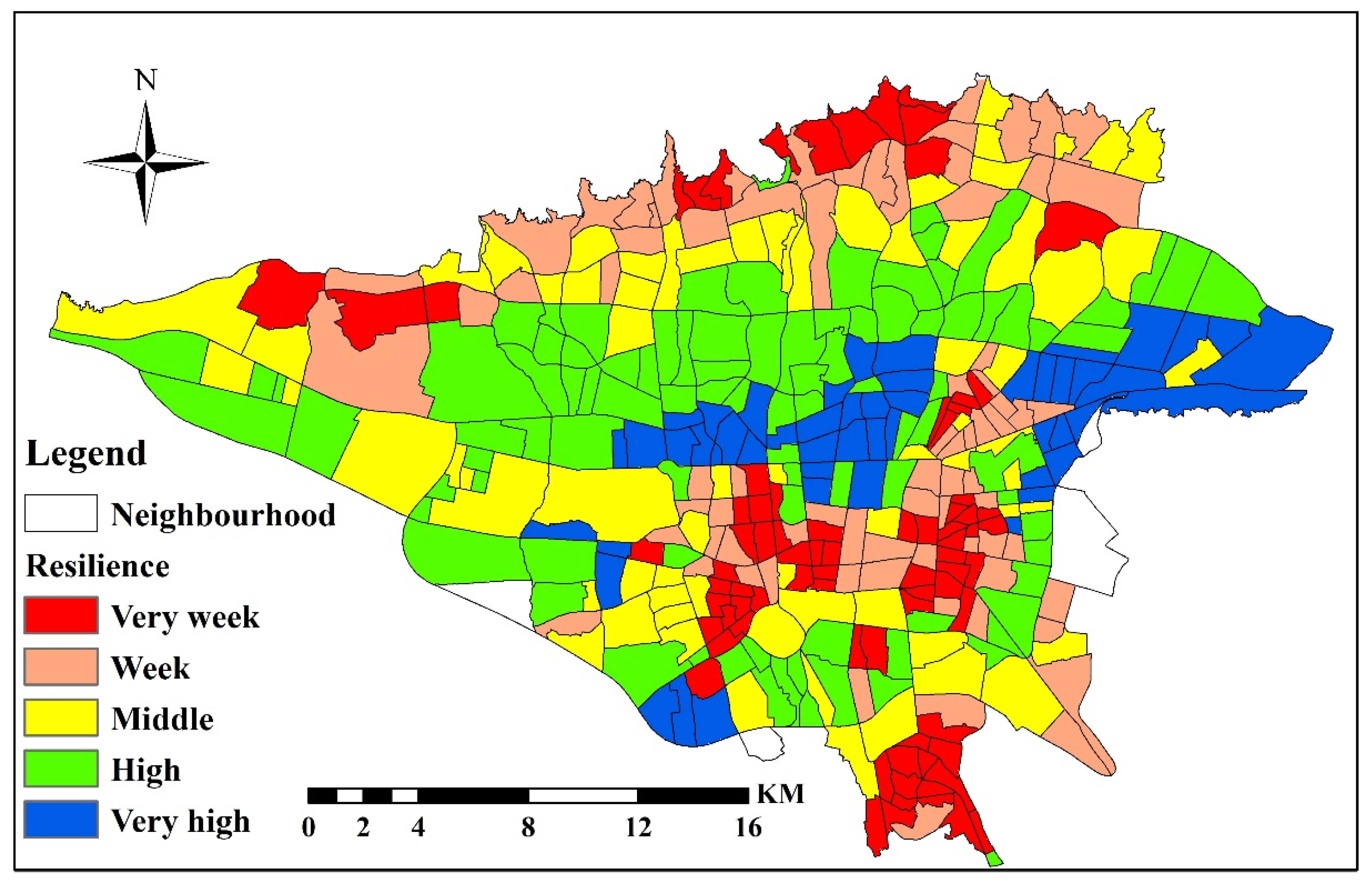
| Criteria | Explanation | Formula | Effect | References |
|---|---|---|---|---|
| Building age (C1) | Increasing the age of the structure has a negative effect on resilience. The information on this criterion was received from Tehran Municipality. | − | [68] | |
| Population density (C2) | With the increase in population, the probability of disaster associated with environmental/human-created hazards increases, and the increase in population density has a negative effect on resilience. Population density is calculated by dividing the population by unit area (hectares or kilometers, etc.). | − | [69] | |
| Distance from fault(C3) | The distance from a fault is one of the parameters directly related to environmental hazards. It emphasizes the reconstruction of high-risk areas in cases of low security levels in terms of population density, etc. Euclidean distance was used for this measure. | + | [70] | |
| Age Composition (C4) | For this criterion, sensitive age groups (young persons less than 14 years old and older persons more than 65 years old) are collected and divided into the total population. Because the population (young and old) are sensitive groups, resilience decreases whenever this ratio increases. | Agecompo = | − | [71] |
| Gender ratio (C5) | This criterion is obtained by dividing the population of women by that of men men, and considering that the women’s society is more vulnerable, a high ratio of this index makes this criterion negative for resilience. | − | [72] | |
| Space syntax (C6) | This criterion shows how each part of the city is connected (streets, metro, BRT, bus). A high value for this index makes this measure positive for resilience because communication is crucial in times of danger. | + | [73] | |
| Distance to a fire station (C7) | As the distance from fire stations increases, resilience decreases. Therefore, increasing this index has a negative effect on resilience. Euclidean distance was used for this measure. | − | [70] | |
| Building materials (C8) | This criterion shows the percentage of use of resistant materials in each region; the information in this section was obtained from the Iranian Statistics Organization. Increasing the percentage has a positive impact. | +/− | [74] | |
| Building prices (C9) | This criterion was determined based on a field survey, the experience of living in the city, and a price comparison using real-estate price software (Version 2.0). A price increase has a negative effect on resilience (increase in the cost of reconstruction leading to capital lost during natural disasters, etc.). | − | [75,76] | |
| Access to Medical Centers (C10) | The subject of this criterion is similar to that of criterion 7. | − | [70] | |
| Green space per capita (C11) | This criterion is obtained by dividing the area of green space by the population, and it positively affects resilience; that is, with an increase in green space per capita, resilience increases. | + | [77,78] | |
| Household density (C12) | This criterion is evaluated by dividing the number of residential units by the area (the area of each neighborhood or region). An increase in this index had a negative effect because, it increases the risk of more residential units being involved at the same time, and at the same time, more people’s consent should be obtained to make games. | − | [79] | |
| The density of educational centers (C13) | The density of education centers is directly related to the increase in society’s awareness. Increasing the density of educational spaces has a direct effect on increasing resilience. | + | [80] | |
| Land use (C14) | The type of land use determines the level of resilience. Therefore, it has a positive or negative effect based on the land-use type in each environment. | +/− | [81] |
| Preferences (Oral Assessment) | Numerical Rating |
|---|---|
| Maximum priority | 9 |
| Very high priority | 7 |
| High Priority | 5 |
| Medium priority | 3 |
| Equal priority | 1 |
| Preferences between these intervals | 2, 4, 6, 8 |
| N | 1 | 2 | 3 | 4 | 5 | 6 | 7 | 8 | 9 | 10 | 11 | 12 | 13 | 14 | 15 |
| RI | 0 | 0 | 0.52 | 0.88 | 1.1 | 1.24 | 1.34 | 1.4 | 1.44 | 1.48 | 1.51 | 1.53 | 1.55 | 1.57 | 1.58 |
| Expert | Civil | Urban Planning | Architecture | Sociology | Transport Specialists | Crisis Management | Environment |
|---|---|---|---|---|---|---|---|
| Number | 3 | 3 | 1 | 2 | 2 | 1 | 1 |
| Educational | Expert | Master | PhD | Postdoc | |||
| Number | 1 | 4 | 5 | 2 | |||
| ABW | 1 | 2 | 3 | 4 | 5 | 6 | 7 | 8 | 9 |
| ) | 0.00 | 0.44 | 1.00 | 1.63 | 2.30 | 3.00 | 3.73 | 4.43 | 5.23 |
| C1 | C2 | C3 | C4 | C5 | C6 | C7 | C8 | C9 | C10 | C11 | C12 | C13 | C14 | |
| C1 | 1 | 3 | 2 | 7 | 8 | 2 | 3 | 1 | 6 | 4 | 9 | 4 | 5 | 6 |
| C2 | -- | 1 | 0.5 | 2 | 3 | 0.5 | 1 | 0.333 | 2 | 1 | 3 | 1 | 2 | 2 |
| C3 | -- | -- | 1 | 4 | 4 | 1 | 2 | 0.5 | 3 | 2 | 5 | 2 | 3 | 3 |
| C4 | -- | -- | -- | 1 | 2 | 0.333 | 0.333 | 0.143 | 1 | 0.5 | 2 | 0.5 | 0.5 | 1 |
| C5 | -- | -- | -- | -- | 1 | 0.25 | 0.333 | 0.125 | 1 | 0.5 | 1 | 0.5 | 0.5 | 1 |
| C6 | -- | -- | -- | -- | -- | 1 | 2 | 0.5 | 3 | 2 | 5 | 2 | 2 | 3 |
| C7 | -- | -- | -- | -- | -- | -- | 1 | 0.333 | 2 | 1 | 3 | 1 | 2 | 2 |
| C8 | -- | -- | -- | -- | -- | -- | -- | 1 | 5 | 4 | 7 | 4 | 4 | 6 |
| C9 | -- | -- | -- | -- | -- | -- | -- | -- | 1 | 0.5 | 2 | 0.5 | 1 | 1 |
| C10 | -- | -- | -- | -- | -- | -- | -- | -- | -- | 1 | 2 | 1 | 1 | 2 |
| C11 | -- | -- | -- | -- | -- | -- | -- | -- | -- | -- | 1 | 0.5 | 0.5 | 1 |
| C12 | -- | -- | -- | -- | -- | -- | -- | -- | -- | -- | -- | 1 | 1 | 2 |
| C13 | -- | -- | -- | -- | -- | -- | -- | -- | -- | -- | -- | -- | 1 | 1 |
| C14 | -- | -- | -- | -- | -- | -- | -- | -- | -- | -- | -- | -- | -- | 1 |
| C | 2 | 3 | 4 | 5 | 6 | 7 | 8 | 9 | 10 | 11 | 12 | 13 | 14 |
| W | 5 | 3 | 8 | 8 | 3 | 5 | 1 | 8 | 6 | 9 | 6 | 7 | 8 |
| C | 1 | 2 | 3 | 4 | 5 | 6 | 7 | 8 | 9 | 10 | 12 | 13 | 14 |
| W | 9 | 6 | 6 | 2 | 3 | 6 | 7 | 9 | 4 | 5 | 5 | 4 | 3 |
| MCDM Method | Resilience Class | |||||
|---|---|---|---|---|---|---|
| Very Low | Low | Middle | High | Very High | ||
| ANP | 28 | 89 | 77 | 103 | 75 | |
| BWM | 64 | 93 | 74 | 98 | 43 | |
| Combined | 83 | 72 | 71 | 95 | 51 | |
| Rank | ANP | BWM | Combined |
|---|---|---|---|
| 1 | Iranshahr | Iranshahr | Iranshahr |
| 2 | Vali Asr | Vali Asr | Vali Asr |
| 3 | University of Tehran | University of Tehran | University of Tehran |
| 4 | Ghaem Magham-Sanai | Ghaem Magham-Sanai | Ghaem Magham-Sanai |
| 5 | IsmailAbad | IsmailAbad | IsmailAbad |
| 6 | Ferdowsi | Parastar | Ferdowsi |
| 7 | Laleh Park | Imamate | Amjadieh-Khaghani |
| 8 | Amjadieh-Khaghani | Ferdowsi | Parastar |
| 9 | Imamate | Amjadieh-Khaghani | Imamate |
| 10 | Parastar | Laleh Park | Laleh Park |
| 11 | Choobtarash | Hakimyeh | Behjat Abad |
| 12 | Behjat Abad | Behjat Abad | Argentina-Saaei |
| 13 | Zanjan | Golshan | Zanjan |
| 14 | Argentina-Saaei | Eastern Tehranpars | Choobtarash |
| 15 | Palestine-Enghlab | Tehran Pars | Eastern Tehranpars |
| 16 | Eastern Tehranpars | Shoora | Tehran Pars |
| 17 | Western Tehranpars | Sorkheh Hesar | Western Tehranpars |
| 18 | Tehran Pars | Western Tehranpars | Palestine-Enghlab |
| 19 | Jahad square | Argentina-Saaei | Shoora |
| 20 | Shoora | Palestine-Enghlab | Golshan |
| Rank | ANP | BWM | Combined |
|---|---|---|---|
| 1 | Sartakht | Sartakht | Sartakht |
| 2 | Mansoorieh and Mongol | Mansoorieh and Mongol | Mansoorieh and Mongol |
| 3 | Jalili | Jalili | Jalili |
| 4 | Eastern Abuzar | Golchin | Eastern Abuzar |
| 5 | Golchin | Mazaheri | Golchin |
| 6 | Southern Armenians | Eastern Abuzar | Mazaheri |
| 7 | Western Khageh Nezami | Buali town | Dejcom |
| 8 | Ahangaran | Ahangaran | Imamzadeh Yahya |
| 9 | Mazaheri | Southern Armenians | FiroozAbad |
| 10 | Dejcom | Mokhaberat town | |
| 11 | Northern Armenians | Dejcom | Anbar Naft |
| 12 | Sarasyabeh Dollab | North Mina | TaqiyAbad |
| 13 | South Mina | Eastern Parvaz | Saffaeh-Cheshme Ali |
| 14 | Shoosh | Northern Armenians | Alaeen |
| 15 | Faruzesh-Amir Bahadur | Shoosh | Shoosh |
| 16 | North Mina | Faruzesh-Amir Bahadur | Rah-Ahan |
| 17 | Southern Selesabil | TaqiyAbad | Golab Dareh |
| 18 | Buali town | South Mina | Agaahi |
| 19 | Chaharsad Dastgah | Western Khageh Nezami | Moghadam |
| 20 | Agaahi | Abshar | Southern Armenians |
Disclaimer/Publisher’s Note: The statements, opinions and data contained in all publications are solely those of the individual author(s) and contributor(s) and not of MDPI and/or the editor(s). MDPI and/or the editor(s) disclaim responsibility for any injury to people or property resulting from any ideas, methods, instructions or products referred to in the content. |
© 2024 by the authors. Licensee MDPI, Basel, Switzerland. This article is an open access article distributed under the terms and conditions of the Creative Commons Attribution (CC BY) license (https://creativecommons.org/licenses/by/4.0/).
Share and Cite
Hosseini, J.; Shakeryari, M.; Nazari Nejad, A.; Mastalizadeh, H.; Maleki, M.; Wang, J.; Rustum, R.; Rahmati, M.; Doostvandi, F.; Mostafavi, M.A. Comparison of the Analytic Network Process and the Best–Worst Method in Ranking Urban Resilience and Regeneration Prioritization by Applying Geographic Information Systems. Land 2024, 13, 1008. https://doi.org/10.3390/land13071008
Hosseini J, Shakeryari M, Nazari Nejad A, Mastalizadeh H, Maleki M, Wang J, Rustum R, Rahmati M, Doostvandi F, Mostafavi MA. Comparison of the Analytic Network Process and the Best–Worst Method in Ranking Urban Resilience and Regeneration Prioritization by Applying Geographic Information Systems. Land. 2024; 13(7):1008. https://doi.org/10.3390/land13071008
Chicago/Turabian StyleHosseini, Javad, Mojtaba Shakeryari, Amir Nazari Nejad, Hamed Mastalizadeh, Mohammad Maleki, Junye Wang, Rabee Rustum, Mahdis Rahmati, Fereshteh Doostvandi, and Mir Abolfazl Mostafavi. 2024. "Comparison of the Analytic Network Process and the Best–Worst Method in Ranking Urban Resilience and Regeneration Prioritization by Applying Geographic Information Systems" Land 13, no. 7: 1008. https://doi.org/10.3390/land13071008
APA StyleHosseini, J., Shakeryari, M., Nazari Nejad, A., Mastalizadeh, H., Maleki, M., Wang, J., Rustum, R., Rahmati, M., Doostvandi, F., & Mostafavi, M. A. (2024). Comparison of the Analytic Network Process and the Best–Worst Method in Ranking Urban Resilience and Regeneration Prioritization by Applying Geographic Information Systems. Land, 13(7), 1008. https://doi.org/10.3390/land13071008









